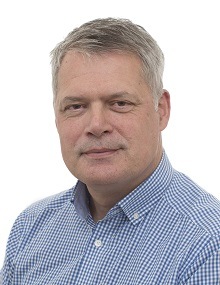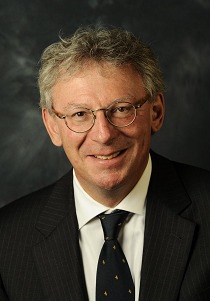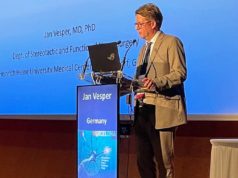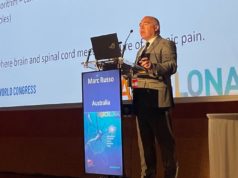
A randomised controlled trial (RCT) presented at the International Neuromodulation Society (INS) congress (21–26 May 2022, Barcelona, Spain) has demonstrated significant and clinically relevant reductions in the frequency of medically intractable chronic cluster headache attacks following occipital nerve stimulation (ONS) therapy.
These findings were presented by Frank Huygen (Erasmus University Medical Center, Rotterdam, The Netherlands), who—on behalf of Michel Ferrari (Leiden University Medical Center, Leiden, The Netherlands) and the other ICON study researchers—also reported that ONS proved to be safe and well-tolerated across more than 100 patients.
After outlining the characteristics and epidemiology of chronic cluster headaches, including the fact that 15% of patients with this condition are refractory or intolerant to preventative medications, he briefly detailed what ONS is and how it works. Huygen told the INS audience that the approach involves subcutaneously implanting two stimulation leads with four electrodes in the occipital region, which are then connected to an implantable pulse generator in the patient’s abdominal or gluteal region.
Huygen highlighted prior literature on the effect of ONS—reporting that early, published case series were positive, but included small numbers of patients and constituted a “very low” quality of evidence. There had also previously been no controlled studies of the approach, he noted.
ICON study
Moving on to the ICON study, the speaker said the aim was to assess the preventive effectiveness and tolerance of ONS in medically intractable chronic cluster headache. Inclusion criteria included, but were not limited to, adult patients (≥18 years) on the International Classification of Headache Disorders-II (ICHD-2) criteria for chronic cluster headache who were deemed ‘medically intractable’.
After a 12-week baseline observation period, eligible patients were randomised 1:1 to receive either high- or low-intensity ONS (100% and 30% stimulation, respectively). A 10-day run-in period with a stimulation intensity set to 10% was followed by a 24-week double-blind period—with stepwise increases in stimulation intensity—and 24 weeks of open-label, optimal treatment.

A total of 130 patients (mean age=44 years, 36% women) were implanted with a stimulation device. One patient was lost from each of the two groups prior to follow-up, leading to 64 patients being available for analysis at 24 weeks. The speaker noted that there were no major differences between the two groups in terms of baseline characteristics.
The study’s primary endpoint was mean attack frequency per week in the final four weeks of the blinded period (week 21 to week 24) compared with baseline across all patients, as well as showing a groupwise difference if a decrease was seen, Huygen said. He also detailed several secondary endpoints including mean attack intensity on a 0–10 numeric rating scale, patient satisfaction and quality of life, (serious) adverse events, and economic outcomes.
New data
Relaying the results from ICON, Huygen said that a statistically significant and clinically relevant reduction in attack frequency was seen in both groups, but there were no noteworthy differences between the two groups. Across the total study population, mean attack frequency decreased by roughly 50%—from 15.75 at baseline to 7.38 during the 21–24-week period. This represented a reduction compared to the mean attack frequency at 1–4 weeks (9.62), although this rate rose slightly to 7.62 through the 45–48-week period.
Huygen then delivered mean attack intensity data, noting a similarly significant and clinically relevant reduction across the total study population, from 7.58 at baseline to 5.57 at 21–24 weeks. Again, however, there was no difference between the 100% and 30% stimulation groups. He also noted that 44.6% of patients were ≥50% responders, and 55.4% of patients were ≥30% responders, at 21–24 weeks.
In terms of quality-of-life measures, mean sum scores for both mental and physical health as per the 36-item Short Form Health Survey (SF-36) increased at 24 weeks compared to baseline—across the entire study population—and then rose again at 48 weeks. The five-point Likert Scale was used to assess patient satisfaction. At 24 weeks, 90.8% of patients said they would recommend ONS, with 74% saying they would strongly recommend it, and this figure climbed to 96.8% (73% strongly) at 48 weeks.
One third of patients in the trial experienced a serious adverse event, which—according to Huygen—is similar to rates seen in other ONS studies. He also noted that, in the open-label study phase, 34 events were observed across 30 patients (23% of the total patient population). In the masked study phase, the number of serious adverse events in the high-intensity stimulation group was greater, at 17 (in 23% of patients), versus eight (in 11% of patients) in the low-intensity group. Huygen detailed that two thirds of these events were battery replacements or dislocated/fractured leads, and said that the rate of non-serious adverse events was also similar to those reported in other ONS studies.
Finally, Huygen reported that, based on patient and neurologist responses at 24 weeks regarding which stimulation intensity they thought they had received/administered, blinding was deemed to have been successful. Briefly touching on long-term follow-up results in the ICON study, he told the INS audience that 35/64 patients (55%) were ≥50% responders, and 84% said they would recommend ONS, at three years, increasing to 22/31 (71%) and a rate of 90% at five years.
Discussing these findings, the speaker said that about 50% of patients experienced a 50% reduction in the frequency of their cluster headache attacks within a matter of weeks—following a stable, 12-week baseline period—and “all other endpoints” also showed significant differences in time as well. After reiterating the lack of difference between the two study groups, Huygen dispelled the idea that the aforementioned reductions could have been powered by the placebo effect, as an “abrupt and long-lasting strong effect” was seen in a severely chronically affected population, and personal attention and interaction was also equal across both groups.
Huygen noted that, in addition to the reduction in attack frequency and intensity it appeared to achieve, ONS was found to be well-tolerated. Low-intensity stimulation (30%) was also found to be effective, he added, claiming that future research should now focus on optimal stimulation parameters. The speaker concluded his presentation by noting that earlier data from ICON, which was conducted at four sites across The Netherlands, Belgium, Hungary and Germany, were published in The Lancet Neurology last year.
Wider significance
Speaking to NeuroNews following the INS congress, Huygen alluded to the importance these data may hold for patients who suffer from persistent chronic cluster headaches. “Of course, it would have been even more convincing if we would have shown a dose-response relation, but there are more than enough arguments to suggest that we are looking at a real effect and it is not a placebo,” he said. “And, if the treatment has effect, it is a real life-changer. Patients regain their lives, participate in work and social life again, and sleep normally once more (attacks often occur at night).

“After the study, we adapted our implantation technique based on new anatomical insights, leading to a section of those who were originally non-responders also becoming responders. We are continuing to look for solutions for the non-responders and, in the meantime, we have long-term data (six years) that will be submitted soon showing a strong, ongoing effect after an even longer period of time.” Huygen also noted that—according to Ferrari, who is a headache neurologist and was his co-lead on the project—no other therapy has been launched for cluster headache patients over the past few decades that boasts an effect that is as convincing as the one seen with ONS.
Discussing wider, potentially ‘real-world’ use of this approach moving forward, Huygen added: “I presume this depends mainly on the different healthcare compensation systems worldwide. In The Netherlands, based on the study results, the treatment is included in the regular package of the healthcare insurance companies and is reimbursed. The analyses of a cost-effectiveness study have yet to be completed, but the impression is that, despite high initial costs, ONS in cluster headache appears to be cost-effective. We also have to keep in mind that—especially for the studied group of patients—there is no alternative treatment available.”












